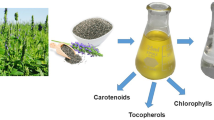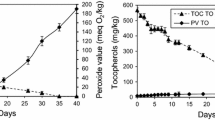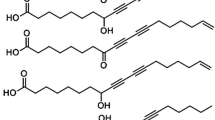Abstract
Omega 3 and 6 fatty acids were enriched in the olein fraction of chia oil via dry fractionation at −30°C. Concentrations of C18:3 (linolenic acid, ω-3) and C18:2 (linoleic acid, ω-6) were 78.16 and 25.42% in the olein fraction. HPLC characterization indicated enrichment of caffeic and chlorogenic acids, quercetin, and phenolic glycosides in the olein fraction. Total antioxidant activities of chia oil and the olein and stearin fractions were 42.5, 53.8, and 34.6%, respectively. After 6 months of storage at 4°C, the concentration of ω-3 in the olein fraction decreased from 78.19 to 76.16%, with a 10% decrease in the ω-3 concentration when the olein fraction was stored at 25°C. The stearin fraction of chia oil exhibited the longest induction period, followed by chia oil and the olein fraction. Amounts of ω-3 and 6 fatty acids can be enriched in the olein fraction from 11.92 and 61.28% to 15.22 and 72.16%, respectively, with reasonable storage stability at low temperature.
Similar content being viewed by others
References
Pawlosky R, Hibbeln J, Lin Y, Salem N. N-3 fatty acid metabolism in women. Brit. J. Nutr. 90: 993–994(2003)
Tepe B, Sokmen M, Akpulat HA, Sokmen A. Screening of the antioxidant potentials of six Salvia species from Turkey. Food Chem. 95: 200–204 (2006)
Woods RK, Thien FC, Abramson MJ. Dietary marine fatty acids (fish oil) for asthma in adults and children. Cochrane DB Syst. Rev. CD001283 (2002)
Ruxton CHS, Reed SC, Simpson MJA, Millington KJ. The health benefits of omega-3 polyunsaturated fatty acids: A review of the evidence. J. Hum. Nutr. Diet. 17: 449–459 (2004)
Hentry HS, Mittleman M, McCrohan PR. Introduction of Chia and tragacanth in the United States. pp. 252–256. In: Advances in New Crops. Janick J, Simon JE (eds). Timber Press, Portland, OH, USA (1990)
Ayerza R, Coates W. Chia: Rediscovering a forgotten crop of the Aztecs. University of Arizona Press, Tucson, AZ, USA. pp. 215–215 (2005)
Borneo R, Aguirre A, León AE. Chia (Salvia hispanica L.) gel can be used as egg or oil replacer in cake formulations. J. Am. Diet. Assoc. 110: 946–949 (2010)
The Chia Company. Request for scientic evaluation of substantial equivalence application for the approval of chia seeds (Salvia Hispanica L.) from The Chia Company for use in bread. Food Standards Agency, London, UK (2009)
Reddy SY. Improving plasticity of milk fat for use in baking by fractionation. J. Am. Oil Chem. Soc. 87: 493–497 (2010)
AOAC. Official Method of Analysis of AOAC Intl. 17th ed. Method Cd 8-53. Association of Official Analytical Chemists, Champaign, IL, USA (2000)
AOCS. Official Methods and Recommended practices of the American Oil Chemists’ Society. 4th ed. Method Ca 5a-40. AOCS, Champaign, IL, USA (1995)
Ogbunugafor HA, Eneh FU, Ozumba AN, Igwo-Ezikpe MN, Okpuzor J, Igwilo IO, Adenekan SO, Onyekwelu OA. Physico-chemical and antioxidant properties of Moringa oleifera seed oil. Pak. J. Nutr. 10: 409–414 (2011)
AOAC. Official Methods of Analyses of AOA. 18th ed. Method Ca 6b-53. Association of Official Analytical Chemists, Champaign, IL, USA (2005)
Metrohm AG. Oxidative stability of oils and fats-Rancimat method. Metrohm application bulletin No. 204/le: Metrohm AG, Herisau, Switzerland. pp. 1–4 (1993)
Badiale-Furlong E, Colla E, Bortolato DS, Baisch ALM, De Souza-Soares LA. Potential evaluation of phenolic compounds in tissues. Veto. 13: 105–114 (2003)
Coelho MS, de las Mercedes Salas-Mellado M. Chemical characterization of CHIA (Salvia hispanica L.) for use in food products. J. Food Nutr. Res. 2: 263–269 (2014)
Steel RGD, Torrie JH, Dickey DA. Principles and Procedures of Statistics. A biometrical approach. 3rd ed. McGraw Hill Book Co, New York, NY, USA. pp. 230–232 (1997)
Ayerza, R, Coates W. Chia seeds: Natural source of omega-3 3 fatty acids. p. 17 In: Annual meeting of the association for the advancement of industrial crops. September 11-14. Fargo, North Dakota, USA (2011)
Rahman F, Nadeem M, Azeem MW, Zahoor Y. Comparison of the chemical characteristics of high oleic acid fraction of Moringa oleifera oil with some vegetable oils. Pak. J. Anal. Environ. Chem. 15: 80–83 (2014)
Fereidoon S. Bailleys industrial edible oil and fat products. 6th ed. John Willey and Sons Pub. Co. New York, NY, USA. pp. 300–305 (2005)
Lokuruka MNI. Role of fatty acids of milk and dairy products in cardiovascular diseases: A review. Afr. J. Food Agric. Nutr. Dev. 7: 1–16 (2007)
Kumar PKP, Gopala Krishna AG. Physico-chemical characteristics and nutraceutical distribution of crude palm oil and its fractions. Grasas Aceite. 65: e018 (2014)
Leaf A, Kang JX. Omega-3 fatty acids and cardiovascular disease. pp. 24–37. In: The return of ω3 fatty acids into the food supply. I. Land-based animal food products and their health effects. Simopoulos AP (ed). Karger Publishers, Basel, Switzerland (1998)
United States Department of Agriculture. Dietary Guidelines for the American. Available from: http://health.gov/dietaryguidelines/dga2005/document/htmL/chapter6.htm. Accessed July 20, 2015.
Erickson DR. Practical hand book of soybean processing and utilization. AOCS Press, Champaign, IL, USA. pp. 70–75 (1995)
Nadeem M, Situ C, Mahmud A, Khalique A, Imran M. The effect of sesame (Sesamum indicum L.) cake extract for oxidative stabilization of olein based butter. J. Am. Oil Chem. Soc. 91: 967–977 (2014)
Reyes-Caudillo E, Tecante A, Valdivia-Lopez MA. Dietary fibre content and antioxidant activity of phenolic compounds present in Mexican chia (Salvia hispanica L.) seeds. Food Chem. 107: 656–663 (2008)
Nadeem M, Abdullah M, Hussain I. Improvement of the oxidative stability of butter oil by blending with Moringa oleifera oil. J. Food Process Pres. 38: 1491–1500 (2013)
Khatoon S, Gopala Krishna AG. Changes in tocopherols, tocotrienols and β-carotene during processing of palm oil extracted from Indian grown palm fruit. J. Lipid Sci. Technol. 39: 63–70 (2007)
Serpen A, Gökmen V, Fogliano V. Total antioxidant capacities of raw and cooked meats. Meat Sci. 90: 60–65 (2012)
Anwar F, Hussain AI, Iqbal S, Bhanger MI. Enhancement of the oxidative stability of some vegetable oils by blending with Moringa oleifera oil. Food Chem. 103: 1181–1191 (2007)
Anwar F, Chatha SAS, Hussain AI. Assessment of oxidative deterioration of soybean oil at ambient and sunlight storage. Grasas Aceite. 58: 390–395 (2007)
Gulla S, Waghray K. Effect of storage on physico-chemical characteristics and fatty acid composition of selected oil blends. J. Lipid Sci. 3: 35–46 (2011)
Baer RJ, Ryali J, Schingoethe DJ, Kasperson KM, Donovan DC, Hippen AR, Franklin ST. Composition and properties of milk and butter from cows fed fish oil. J. Dairy Sci. 84: 345–353 (2001)
Maria A, GromponeIrigaray B, Rodríguez D, Sammán N. Assessing the oxidative stability of commercial chia oil. J. Food Sci. Eng. 3: 349–356 (2013)
Author information
Authors and Affiliations
Corresponding author
Rights and permissions
About this article
Cite this article
Ullah, R., Nadeem, M., Ayaz, M. et al. Fractionation of chia oil for enrichment of omega 3 and 6 fatty acids and oxidative stability of fractions. Food Sci Biotechnol 25, 41–47 (2016). https://doi.org/10.1007/s10068-016-0006-x
Received:
Revised:
Accepted:
Published:
Issue Date:
DOI: https://doi.org/10.1007/s10068-016-0006-x




